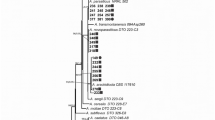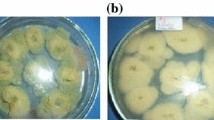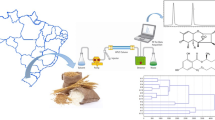Abstract
Cassava bread was prepared by pre-gelling, battering and baking cassava flour to which were added, in moderate amounts, sugar, yeast solution and edible oil. Baking was at 215°C for 40 min. No mould was isolated from the cassava bread and the mean value of aflatoxin B1 (AFB1) for the three subsamples of cassava bread was 0.03 µg/kg. The cassava tuber (Manihot esculenta Crantz), which was used for the production of cassava bread had an initial AFB1 level of 1.91 µg/kg and the dominant mycoflora werePenicillium oxalicum, Aspergillus flavus, Fusarium spp and some unidentified fungi.
Similar content being viewed by others
References
Adegoke GO, Babalola AK, Akanni AO (1991) Effects of sodium metabisulphite, hydrogen peroxide and heat on aflatoxin B1 in lafun and gari-two cassava products. Die Nahrung 35: 1041–1045
Akinrele IA (1964) Fermentation of cassava. J Sci Fd Agric 15: 589–594
Anonymous (1985) Cassava: more than a famine reserve crop. The Radix 7: 1-3
Asplin FD, Carnaghan RBA (1961) The toxicity of certain ground-nut meal for poultry with special reference to their effect on duckling and chickens. Vet Rec 73: 489–499
Barnett HR, Hunter BB (1972) Illustrated genera of imperfect fungi. Minneapolis: Burgess Publishing Co.
Centro International de Agriculture Tropical (CIAT) (1984) Cassava Newsletter 8: 1–2
Coker RD, Jones BD, Nagler MJ, Gilman GA, Wallbridge AJ, Panigrahi S (1984) Mycotoxin Training Manual. London: TDRI Sect. A8
Cooke RD, Coursey DG (1981) Cassava: a major cyanide containing food crop. In: Vennesland B, Conn EE, Knowles CJ, Westley J, Wissing F (eds), Cyanide in Biology. London: Academic Press, pp. 93–114
Davis ND, Dickens JW, Freie RL, Hamilton PB, Shotwell OL, Wyllie TO, Fulkerson JF (1980) Protocols for surveys, sampling, post-collection handling and analysis of grain samples involved in mycotoxin problems. J.A.O.A.C. 63: 95–102
Davis ND, Diener UL (1987) Mycotoxins in Food and Beverage Mycology. Beuchat LR (ed). New York: Van Nostrand Reinhold, pp. 517–570
Domngang F, Kandem L, Moundipa P (1984) Presence of aflatoxin in certain Cameroonian dishes. Ann Fac Sci (Biol Biochem) 2: 93–102
Doyle MP, Applebaum RS, Brackett RE, Marth EH (1982) Physical, chemical and biological degradation of mycotoxins in foods and agricultural commodities. J Fd Prot 45: 964–971
Etejere EO, Bhat RB (1985) Traditional preparation and uses of cassava in Nigeria. Econ Bot 39: 157–164
Food and Agriculture Organization (FAO) (1979) Perspective on Mycotoxins. Rome: FAO, Food and Nutrition Paper 13, pp. 19, 104
Food and Agriculture Organization (FAO) (1989) Wheatless Bread. Rome: FAO, pp. 6–7
Fenwick GR, Johnson IT, Hedley CL (1990) Toxicity of disease resistant plant strains. Trends in Fd Sci & Technol 1: 23–28
King SB, Wallin JR (1983) Aflatoxin andAspergillus flavus in corn. South Coop Ser Bull 279: 77–80
Nigerian Tribune (1989) Garideath, not due to cyanide-communique Dec. 1989, Ibadan, Nigeria
Raper KB, Fennel DI (1965) The genusAspergillus. Baltimore: Williams and Wilkins
Rogers DJ (1965) Some botanical and ethnological consideration ofManihot esculenta. Econ Bot 19: 369–377
Serck-Hanssen A (1970) Aflatoxin-induced fatal hepatitis: a case report from Uganda. Arch Environ Hlth 20: 729–731
Therberger RL, Caveness FE, Herren HR, Lena KM, Neuenschwander P, Yaninek JS (1985) Common African pests and diseases of cassava. Ibadan: International Institute of Tropical Publc., pp. 2–22
Trucksess MN, Brumley WC, Nesheim S (1984) Rapid quantification and confirmation of aflatoxin in corn and peanut butter using disposable silica gel TLC and gas chrom/mass spec. Assoc Off Anal Chem 67: 973–975
Van Egmond HP (1989) Mycotoxins in dairy products. New York: Elsevier, pp. 1–9
Author information
Authors and Affiliations
Rights and permissions
About this article
Cite this article
Adegoke, G.O., Akinnuoye, O.F.A. & Akanni, A.O. Effect of processing on the mycoflora and aflatoxin B1 level of a cassava-based product. Plant Food Hum Nutr 43, 191–196 (1993). https://doi.org/10.1007/BF01886219
Received:
Accepted:
Issue Date:
DOI: https://doi.org/10.1007/BF01886219




